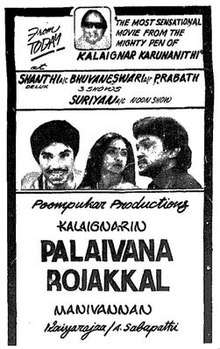Palaivana Rojakkal
| Palaivana Rojakkal | |
|---|---|
 Theatrical release poster | |
| Directed by | Manivannan |
| Produced by | Murasoli Selvam |
| Screenplay by | M. Karunanidhi |
| Story by | T. Damodaran |
| Starring |
Sathyaraj Lakshmi Nalini Prabhu |
| Music by | Ilaiyaraaja |
Production company |
Poompuhar Productions |
Release date |
|
| Country | India |
| Language | Tamil |
Palaivana Rojakkal (lit. Desert roses)[1] is a 1986 Indian Tamil-language political satire film written by M. Karunanidhi and directed by Manivannan. It is a remake of the Malayalam film Vartha, released earlier the same year. The film stars Sathyaraj, Lakshmi, Nalini and Prabhu in lead roles.
Plot
A journalist, his lover and his friend fight a corrupt system to expose unscrupulous politicians.[2]
Cast
- Sathyaraj as Sabarathinam[3]
- Lakshmi as Surya[4]
- Nalini as Rani[4]
- Prabhu as Babu[4]
- Malaysia Vasudevan as VJV
- Vasanth as Sekar
- Vinu Chakravarthy as Aalavandhan
- S. S. Chandran as Kannayiram
- Delhi Ganesh as Chinnaiah
- Janagaraj as Majunu
- Venniradai Moorthy as P.A of Aalavandhan
- Thyagu as Ekambaram
- Charuhasan as Sabarathinam's Grandfather
- Madhuri as Shanthi
- Chinni Jayanth as Sekar's Friend
- Kamala Kamesh as Saraswathi (Guest appearance)
- Vijayan (Guest appearance)
Production
Palaivana Rojakkal is a remake of the 1986 Malayalam film Vartha.[5] M. Karunanidhi wrote the screenplay and dialogue, while Manivannan directed the film, which was produced by Murasoli Selvam under Poompuhar Productions.[6][3] Sathyaraj said he accepted to act in the film because it was a remake of a successful film, and was guaranteed to do well.[7]
Themes
Palaivana Rojakkal is about "the struggle between corrupt politicians and angry heroes".[8] The Economic and Political Weekly considered that Karunanidhi, unlike in Manohara (1954) where he "virtually blasted the audience with extremely dramatic, alliterative dialogues", used "a far more subdued and sophisticated style to convey his political message" in this film.[9]
Soundtrack
The soundtrack was composed by Ilaiyaraaja, while the lyrics were written by Gangai Amaran.[10]
| No. | Title | Singer(s) | Length |
|---|---|---|---|
| 1. | "Kadhal Enbadhu" | Ilaiyaraaja | |
| 2. | "Thoranthu" | Vani Jairam | |
| 3. | "Nenachathellam" | Ilaiyaraaja |
Release and reception
Palaivana Rojakkal was released on 1 November 1986, during Diwali day.[11] In a review dated 7 November 1986, The Indian Express wrote, "One sees [Karunanidhi's] stamp in the hyperbolic references to the pen being mightier than the sword, and in certain needless allusions, but these however are not too long or too frequent to detract from the value of the film. The main strength of [Palaivana Rojakkal] is that it has some lively characters."[6] Ananda Vikatan, in a review dated 23 November, rated the film 51 out of 100.[12] Despite facing competition from Maaveeran and Punnagai Mannan,[13] the film emerged a commercial success, and was instrumental in establishing Sathyaraj as a "mass hero".[14] It also led to a slew of political films being made, mainly those which spoke against MLAs and ministers, depicting them as womanisers, drunkards and wheeler dealers.[2]
References
- ↑ Pillai, Sreedhar (15 January 1988). "Rush of contenders for top place in Tamil films". India Today. Archived from the original on 21 June 2018. Retrieved 3 August 2018.
- 1 2 Shekhar, G. C. (1989). "Action!". The Telegraph.
- 1 2 Dhananjayan 2011, p. 105.
- 1 2 3 Dhananjayan 2011, p. 106.
- ↑ The Illustrated Weekly of India 1987, p. 40.
- 1 2 "Fruits of Honesty". The Indian Express. 7 November 1986. p. 14.
- ↑ The Illustrated Weekly of India 1987, p. 41.
- ↑ Maderya, Kumudan (2010). "Rage against the state: historicizing the "angry young man" in Tamil cinema". Jump Cut. Archived from the original on 23 May 2017.
- ↑ Economic and Political Weekly. 31. Sameeksha Trust. 1996. p. 1881.
- ↑ Ilaiyaraaja (1986). "பாலைவன ரோஜாக்கள்" (in Tamil). Echo Records. Archived from the original on 30 May 2018.
- ↑ "Palaivana Rojakkal". The Indian Express. 1 November 1986. p. 7.
- ↑ "பாலைவன ரோஜாக்கள்". Ananda Vikatan (in Tamil). 23 November 1986.
- ↑ "Rajinikanth turns 67: More than moondru mugam". The New Indian Express. 11 December 2017. Archived from the original on 20 April 2018. Retrieved 20 April 2018.
- ↑ "Sibiraj is all set to make it big!". Sify. 7 November 2004. Archived from the original on 2 November 2017. Retrieved 2 November 2017.
Bibliography
- Dhananjayan, G. (2011). The Best of Tamil Cinema, 1931 to 2010: 1977–2010. Galatta Media. ISBN 978-81-921043-0-0.
- The Illustrated Weekly of India. 108. 29 November 1987.